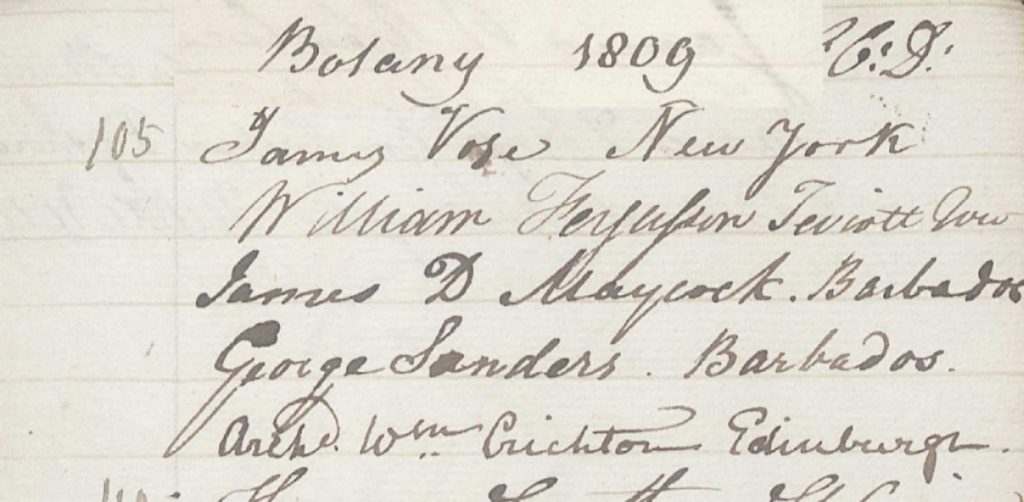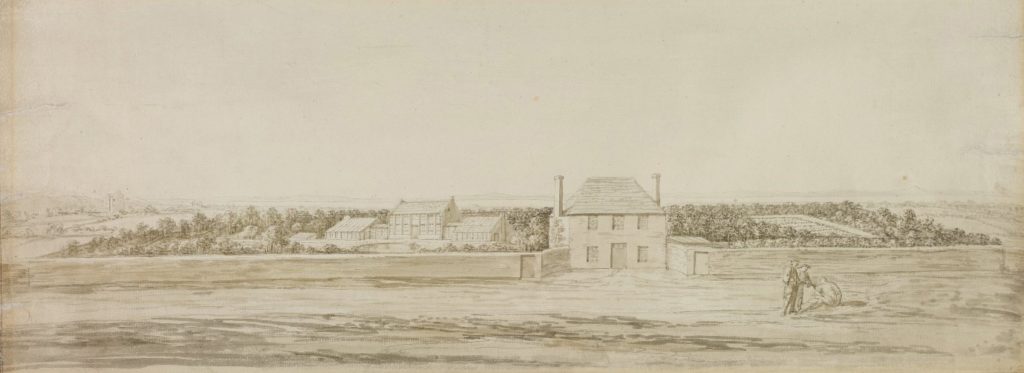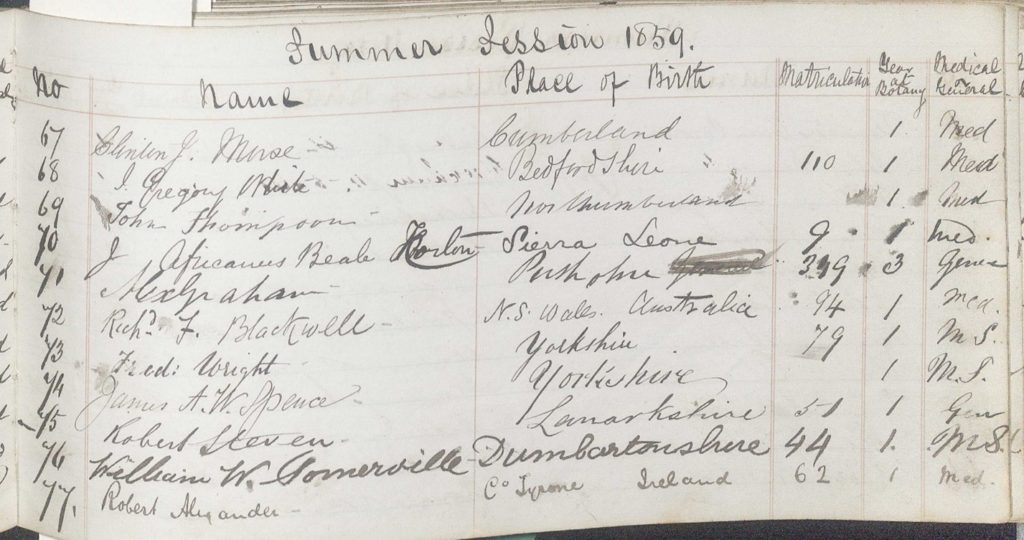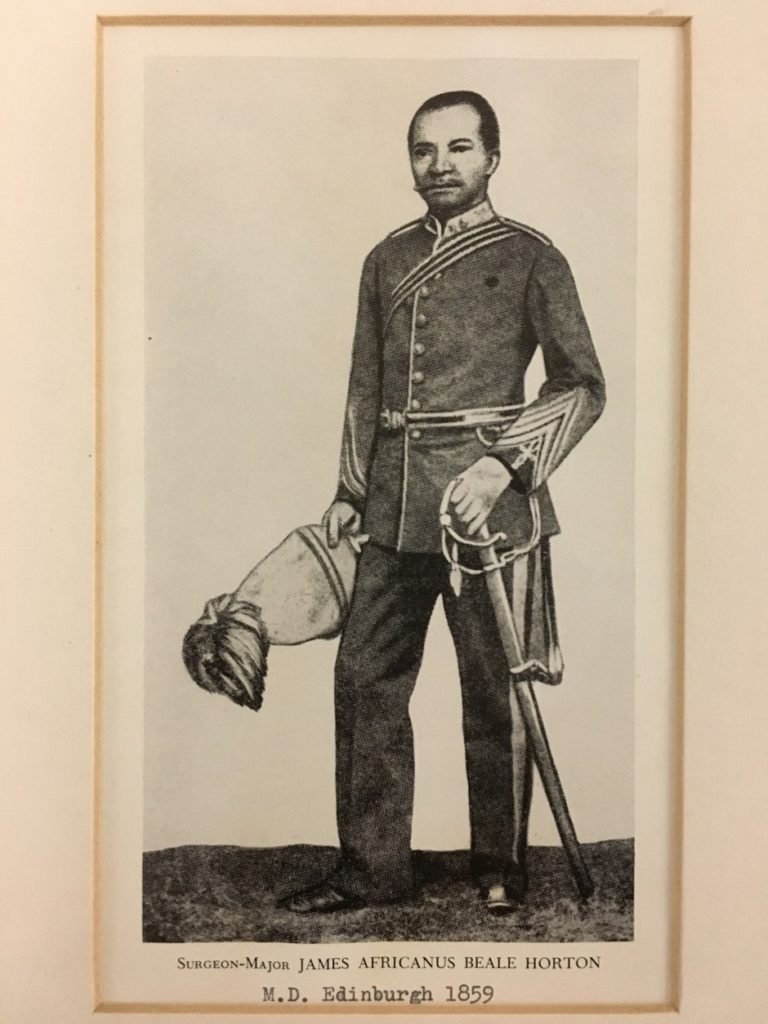This Black History Month, we explore our links with Dr William Fergusson (1796 – 1846) and Surgeon-Major James ‘Africanus’ Beale Horton (1835 – 1883). Both men attended botany classes at the Royal Botanic Garden Edinburgh in the 1800s as part of their medical studies with The University of Edinburgh and The Royal College of Surgeons.
William Fergusson is the first known student of African descent to attend The University of Edinburgh. He was born in Jamaica in 1796 to an African Jamaican mother and Scottish father. At just 14 years of age, he was enrolled by the University for a medical qualification at Edinburgh’s Royal College of Surgeons.
Our Register for Botany Classes from over 200 years ago, held in our Library Archives, records Fergusson’s signature as an attendee of the Summer Sessions of 1809.

Above: Class of 1809 showing William Fergusson’s name and address in Edinburgh
In those days, the Garden was located to the east of Edinburgh on the city’s famous Leith Walk. Fergusson would have attended lectures along with 126 other students in the Botanic Cottage classroom led by the Regius Keeper of the time and Professor of Botany Dr Daniel Rutherford.

Above: The Botanic Cottage at the Royal Botanic Garden Edinburgh, Leith Walk.
Dr Rutherford was described by one of his pupils as a ‘little, sluggish-looking man’ who ‘always seemed to lecture with a grudge’. However, ‘His lectures were extremely clear, and full of condensed information; his style was beautiful, and his pronunciation pure … consequently his class, a large one in spite of the early hour of eight in the morning and the long distance to the garden, always listened to him attentively and treated him with respect’.
The Professor did not conduct botanical excursions as part of the course and so it is unlikely that Fergusson would have studied botany out in the field although some students did so under their own steam. Instead, Rutherford brought specimens into the classroom with the help of his head gardener, William McNab.
‘The doctor had a detestation of foul smells yet was fascinated by an irresistible necessity when an ill smelling plant came in his way. “Gentlemen,” said he one day, “this is the henbane plant, the Hyoscyamus niger … It may also be known by a very peculiar, disagreeable odour, a most offensive odour.” Whereupon, raising the nosegay to his nostrils, and whiffing it slightly, he went off in a fit of spasmodic movements as if choking, and called out with a cross air, “Take it away, Mr McNab! Take it away!”
Botany classes in the early 1800s
The lectures on botany are delivered in the Botanic Garden during the summer season, viz. in the months of May, June, and July. The course begins with a short history of botany and botanical authors. This is followed by an account of the general structure and conformation of the various parts of vegetables; after which, is given the foundation of botanical arrangement, as an introduction to the explication of the Linnæan or sexual system. This system is illustrated by short histories of the various plants comprehended under the different classes, particularly of such as are of most use in medicine and the arts, and of the exotic plants preserved in the Garden; at the same time, the different natural orders that may happen to fall within these classes, are particularly noted and characterized. The course concludes with the general facts and doctrines respecting vegetation.
After becoming a licentiate for the Royal College of Surgeons of Scotland in 1813, Fergusson was posted as a second surgeon to the colony of Sierra Leone where he spent much of his life. In 1845, he became governor of Sierra Leone. Indeed, he was first and last governor of a British African colony who was of African descent. Unfortunately, he died at sea a year later while returning to Britain. A gravestone in his memory is located at Warriston Cemetery close to the Royal Botanic Garden Edinburgh.
In 1842, the Garden has record of receiving Amaryllis seeds ‘of a bulbous root’ which ‘flowers twice years’. The seeds collected by Fergusson in Sierra Leone were presented to the Botanical Society of Edinburgh by his daughter Elizabeth.
Above: Botanical illustration of Amaryllis ornata from Sierra Leone published as plate 1253 in Curtis’s Botanical Magazine on 1 January 1810
James ‘Africanus’ Beale Horton is considered to be The University of Edinburgh’s first African graduate. He was born in Sierra Leone in 1835. Both his mother and father were liberated from slavery and resettled there. In 1853, Horton was among the first Africans to travel to Britain to study for a medical degree and he attended botany classes at the Garden in 1859.

Above: Class of 1859 showing J Africanus Beale Horton’s name and place of birth on the fourth line.
Beale Horton’s teacher was Regius Keeper and Professor of Botany John Hutton Balfour, an inspiring teacher who oversaw a major period of growth of the Garden at Inverleith, where it is located today. He greatly expanded teaching and research, developed the Glasshouses and added the Temperate Palm House. The Garden was just 17 acres in 1859 compared to its 72 acres today.
Botany studies had diversified by the 1850s and in the Summer Session of 1859 Beale Horton, along with 253 other students, studied the classification of plants, geographical and palaeontological botany, vegetable physiology and organography. They attended 64 lectures, 37 demonstrations and 12 weekly examinations.
The Professor was particularly keen on the use of botanical excursions, taking his students on field trips around Scotland and beyond. His diaries were crammed full of train tickets, hotel bills and plant lists. That summer, Beale Horton and his fellow students travelled nearly 900 miles by train and on foot to undertake field studies, costing the Botanics 35 shillings, and they collected nearly 1,000 plant species.
Botany Classes in the 1850s
Lectures at the Royal Botanic Garden every Monday, Tuesday, Wednesday, Thursday, and Friday, at 8 a.m., from the beginning of May till the end of July. Examinations take place in the Mathematical Class-room at the College every Wednesday, at 3 P.M. Demonstrations are given (from 9 to 10 a.m.) on the Natural Orders, in the open ground of the Garden; on the Preparations, in the Museum of Economic Botany; and on the Plants, in the Hot-houses. Saturdays are occupied with Excursions and Demonstrations in the fields. The rooms at the Garden are open to pupils for the consultation of Botanical Works, for the examination of Specimens, and for the use of the Microscope. Prizes are given for Herbaria, Essays, Museum Preparations, and Competition Examinations.

Above: Surgeon-Major James Africanus Beale Horton pictured in 1859.
Sierra Leone links the stories of Dr Fergusson and Surgeon-Major Beale Horton, along with their medical expertise and knowledge of botany. Greg Kenicer, Head of Undergraduate Education and Profession Learning at the Royal Botanic Garden Edinburgh says: “The Garden has always been a place of learning, from its origins as a physic garden, training physicians in the plants of their medical trade. Our tens of thousands of alumni over the years have gone on to do amazing things all over the world. Fergusson and Beale Horton are superb examples – true healthcare pioneers. It is superb to see things come full circle too with the wealth of the Garden’s archives becoming an invaluable resource for students today, exploring the students of our past.”
Researched by Graham Hardy, RBGE’s serials librarian and written by Paula Bushell head of marketing and communication.
Special thanks to: Dr Tom Cunningham, honorary fellow, history, classics and archaeology, The University of Edinburgh and the team at Global Communications for their permission to quote from the Uncovered Project and to use the image of James Africanus Beale Horton.
https://www.ed.ac.uk/global/uncovered/1800-1859/james-africanus-beale-horton
Other historical facts about Fergusson from:
Fyfe, C, 2004, Fergusson, William (1795?–1846), Oxford Dictionary of National Biography, Oxford University Press, online edn. [http://www.oxforddnb.com/view/article/49294] accessed 03/08/16
Shepperson, G, 1964, James Africanus Beale Horton, West African Countries and Peoples, Edinburgh.
Account of Professor Rutherford’s classes from: The Life of Sir Robert Christison, Bart., in two volumes. Volume I. Autobiography. Edited by his sons. Edinburgh: William Blackwood & Son. (1885), pages 53-56.
Account of Professor John Hutton Balfour classes from: Edinburgh University Calendar for the Session 1858-59. Edinburgh: Thomas Constable & Co (1858) accessible on the Internet Archive at https://archive.org/details/edinburghunivers01
Record of Amaryllis seeds received from Miss Fergusson: Page 101 in Seeds Received 1838-1844 Ledger held in Royal Botanic Garden Edinburgh Archives
[Balfour, I.B.] (1902). History of the Royal Botanic Garden, Edinburgh. Botanical excursions made by Professor John Hutton Balfour, in the years from 1846 to 1878 inclusively. Notes from the Royal Botanic Garden Edinburgh, 2: 21-497. Edited version of original manuscript diaries held in RBGE Archives.

